ODYSSEY: THE PODCAST – my 14 episode, 24 hour sequel to Trojan War: The Podcast – is now recorded and waiting for you. Subscribe through your usual podcast provider, or go to odysseythepodcast.com!
THE STORY (60 minutes) Odysseus finally decodes the cryptic prophecy that “Troy’s walls will never be destroyed by an enemy force”, then sets to work on implementing the most audacious – and famous – “con” in the history of war.
THE COMMENTARY WAS THERE EVER REALLY A TROJAN HORSE? (20 minutes; begins at 1:00:06)
I begin this post-story commentary with a definitive: “Yes, there really was a Trojan Horse”. Homer’s Odyssey (c. 750 BCE) and Virgil’s Aeneid (c. 20 BCE) both tell us that there really was a giant wooden horse, and that is good enough for me. Both Homer and Virgil employ “eye-witness” accounts of the famous horse; Homer’s witnesses were men hidden in the horse’s hollow belly, while Virgil’s witnesses were Trojans on the ground. I note that the “canonical” version of the Trojan Horse story comes to us not via Homer, (who only mentions the horse briefly in the Odyssey) but via Virgil (who offers a detailed and compelling complete version of the entire horse caper in Book Two of the Aeneid).
Then I turn to the objections of the “wooden horse non-believers”. They fall into two broad camps. Camp #1 argues that a wooden horse (as described by Homer and Virgil) could not have existed for logistical and mechanical reasons. Folks in this camp first point out that it would have taken months to construct a horse of the size and “hollow belly capacity” required, and during those months the Trojans from their high walls would have had a clear view of the construction project taking place across the Trojan plain, and no doubt would have seen that the horse was hollow. And, hence, would not have allowed it into their city. The second argument in this camp is based on weight and mobility issues. The gist of the argument goes something like this: Bronze Age technology was incapable of constructing a structure large enough to house 30 soldiers, tall enough to be higher than Troy’s walls, but still mobile enough to be transported across the Trojan Plain, from construction site to those walls. And therefore there could not have been a wooden horse as described in the canonical account.
This leads us to Camp #2 of the “wooden horse non-believers”. These folks generally base their arguments against the wooden horse on the belief that “Even the Trojans could not have been THAT stupid!” And therefore, whatever is was that destroyed Troy, and whatever you wish to call it, it was certainly NOT a large hollow wooden horse on wheels. So what was the “real” Trojan Horse?
The most popular argument is that the horse was simply a huge battering ram that somehow managed to affect a breach in Troy’s walls (or gates). Apparently a contemporary Bronze Age culture (the Assyrians) routinely used battering rams in siege warfare – and this is intriguing – protected the soldiers doing the “ramming” by covering the battering rams in wet animal hides (horse hides anyone?). Sometimes they even painted animal faces or images on to the rams (a horse face anyone?). So the Trojan “horse”, this argument concludes, was simply a gigantic, animal skin covered, possible painted, battering ram.
The preceding theory, however, of necessity has to abandon the prophecy that “the walls of Troy will never be destroyed by an enemy force”. So I prefer the following, much more elaborate, hypothesis.
Archaeologists tell us that “Priam’s Troy” was most likely either Troy 6, or Troy 7a. Troy 6 was a large wealthy city destroyed c 1250 BCE; Troy 7a, a much smaller and less wealthy city, was destroyed by warfare and fire c 1184 BCE. Now in this particular hypothesis, Troy 6 was Priam’s Troy. And we know that Troy 6 was destroyed by an earthquake, at about the same date as some historians argue that Priam’s Troy fell. Now recall that in Greek mythology, Poseidon “the earthshaker god” is the cause of earthquakes. Now further recall that in Greek mythology Poseidon was the angry, unpaid, original builder of Troy’s walls, waiting for a moment to exact his revenge on the city. And finally recall that in Greek mythology Poseidon was symbolically represented by a horse (in the same manner as: Zeus/eagle; Hera/peacock; Athena/owl). So ….. the “horse” that destroyed Troy was actually the god Poseidon, who sent a huge earthquake to knock down Troy’s famous walls. And once the walls were down, the Greeks (catching wind of this fortunate seismic event) sailed across the Aegean Sea and sacked the unprotected city of Troy 6. (Note: The cool thing about this hypothesis is that it equally works if Priam’s Troy was actually Troy 7a. In the 7a version of the hypothesis, an earthquake destroyed a very wealthy and wall-protected Troy 6 in c 1250 BCE. Then the Trojan survivors rebuilt a much smaller, un-walled city that we call Troy 7a. And about 70 years later, c 1184 BCE, the Greeks sailed across the Aegean Sea, attacked Troy 7a, and burned it to the ground. And why could the Greeks destroy Troy 7a so easily? Because Poseidon’s “Trojan Horse” earthquake of about 70 years earlier had already rendered the city vulnerable to attack).
I conclude by noting that there are myriad other arguments, theories and creative accounts of how Troy fell, and of the role of the Trojan Horse (whatever it was) in that fall. Historians, archaeologists, authors (and now podcasters) have been happily playing with the story for thousands of years.
Jeff
RELATED LINKS
- MONTY PYTHON’S TROJAN RABBIT (awesome YOUTUBE video)
RELATED IMAGES
- BOOK A LIVE TELLING or “EDU-TAINMENT” (click here)
- PROCESSION OF THE TROJAN HORSE, Giovanni Tiepolo (1727–1804)
- ANOTHER TROJAN HORSE
- NOT TOO SUBTLE HOLLOW BELLY
- TROJAN HORSE c 675-650 BC
- HORSE AT MODERN TROY TOURIST TRAP
- GREEK MYTH COMIX PAPER HORSE (click link to this FUN website!)
- SINON TELLS HIS LIE (artist unknown)
- SINON LIES TO PRIAM (artist unknown)
- LAOCOON & HIS SONS (Vatican Museum; artist and date unknown)
- CUTAWAY DIAGRAM OF TROY’S 1-9
- POSEIDON WITH HORSES
- TROY (a fun trilogy by David Gemmell)


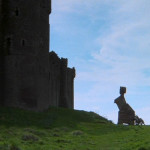

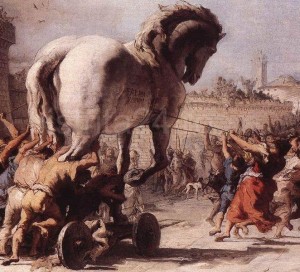
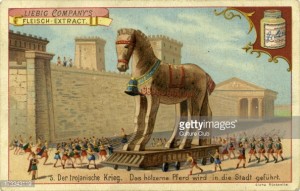
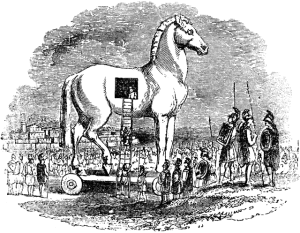
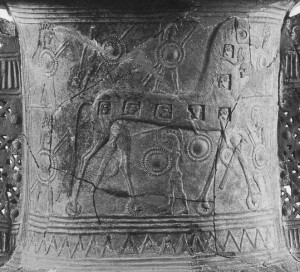
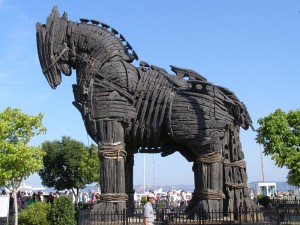
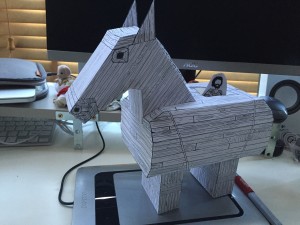
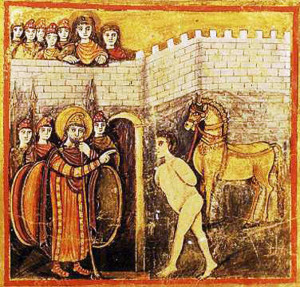
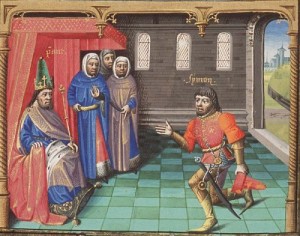
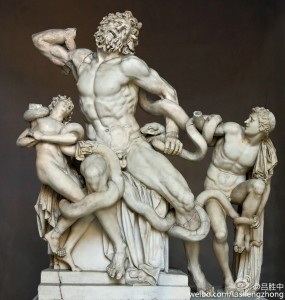
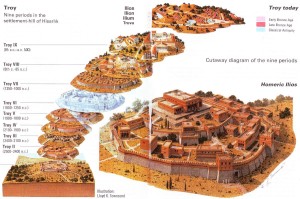
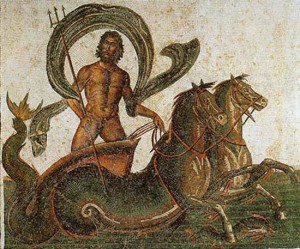

Thank you so much for doing this podcast! I’ve really enjoyed it!
Thanks for the kind words, and I am delighted that you are enjoying the podcast! If you are feeling really grateful a positive review on the ITunes page would help attract other listeners to the podcast. Just go to the ITUNES store, type in my podcast title, and leave a review! Have an awesome day! Jeff
Thank you for the podcast, which I really enjoyed.
Glad to hear that you’ve enjoyed the podcast! If you are feeling generous, a review on ITUNES would help future listeners know that it’s worth listening to. Have a great day! Jeff
You are welcome! Glad that you enjoyed the story. Be sure to share your podcast love with your friends! Jeff
The horse would of been built on a platform remembering the Greeks didn’t want the horse to be moved. They wouldn’t of used wheels. The platform would allow for a huge horse to of been built. Those gates had to be huge. The horse had to be huge. It would of been pulled in with large teams of oxen rolled over logs. I don’t know why they needed thirty men, but the best way to of his them in the horse would of been with them laid out on the floor then covered with something in case they did look in.
One of the things that I like most about hearing this story, is learning about all the modern sayings and names that have roots in the trojan war story. Regarding that, after episode one, I thought that the saying “beware of Greeks bearing gifts” came from the golden apple wedding gift, given from the goddess of discord. But now it seems like it might come from the trojan horse. I’m curious if it’s one or the other, or both?
MAJOR PLOT SPOILER FOR EPISODE 19 FOLLOWS:
The famous saying “Beware of Greeks bearing gifts” is a loose English translation of the Latin words found in Virgil’s Aeneid, Book 2, line 49. In that scene, the Trojan priest Laocoon attempts to warn the Trojan people that the wooden horse is “bad news”. He says: “Do not trust the horse, Trojans! Whatever it is, I fear the Danaans (Greeks), even when bringing gifts.” Needless to say, the Trojans (with a little help from Poseidon) choose to ignore Laocoon’s sensible advice.
To my knowledge, the saying is never used in reference to the Apple of Discord> It would have to be “Beware of goddesses bearing gifts”.
Jeff